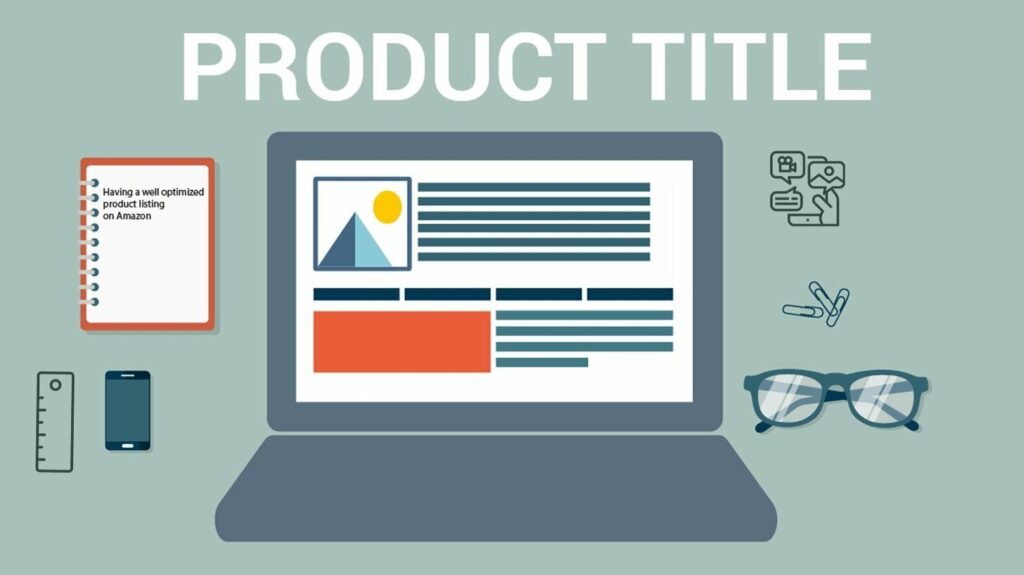Boost Sales with Product Listing Optimization
Ever thought about why some products sell a lot while others don’t? The answer usually lies in how well their listings are made. If you sell on Amazon or run your own store, learning e-commerce optimization is key. It boosts visibility and sales significantly.
Listing your products right is not just trendy; it’s a smart move. It includes SEO for product listings, keyword research for product listings, and creating content that catches the eye. By improving your titles, descriptions, and images, you rise in search results and attract more interest. Want to know more about this magic?
Let’s dig deep into optimizing product listings. We’ll explore how you can use proven methods to make your products shine online.

Key Takeaways
- Strategic product listing optimization significantly boosts product discoverability.
- Incorporating effective keywords can improve SEO for product listings.
- High-quality visuals and engaging content enhance customer engagement and conversion rates.
- Utilizing A/B testing tools offers valuable insights into what content drives sales.
- Implementation of optimized listings can lead to better rankings on platforms like Amazon.
Understanding the Importance of Product Listing Optimization
Turning product listings into powerful assets makes them show up more in search results. This helps people find what they’re looking for more easily. When sellers carefully optimize their product listings, their items become more attractive and easier for shoppers to find.

With the right changes, listings not only rank better in searches but also catch the eye of the desired audience. This strategy works well with search tools and aligns with what shoppers are looking for, leading to increased sales over time.
Improving product listings does more than just make items easier to find. It helps sellers to sell more online and build a stronger base of loyal shoppers. By using smart details, good images, and clear descriptions, these companies turn searches into sales, boosting their business significantly.
Effective Keyword Research for Product Listings
Want to make your products stand out? Effective keyword research is key. It involves research of potential search terms and using specialized tools to find the best keywords.
Initial Research and Analysis
Begin by considering what search terms your potential customers might use. Understanding your audience’s search habits is invaluable. Analyze the top-performing products in your category to gain insights into the keywords they are targeting. This initial research phase is crucial for identifying relevant keywords and setting the foundation for the next steps.
Using Keyword Research Tools
Specialized tools like MerchantWords and Helium 10 simplify the keyword research process. These tools provide extensive lists of relevant keywords, along with data on their popularity and search volume. By incorporating the right keywords into your product listings, you signal to algorithm that your product matches what customers are searching for, increasing the likelihood that your product will appear in search results.
Implementing Keywords in Your Listings
Once you have identified a list of effective keywords, strategically incorporate them into various elements of your product listings:
Title: Include primary keywords to make your product easily identifiable.
Bullet Points: Use keywords naturally within bullet points to highlight key features and benefits.
Product Description: Ensure the description is rich with keywords but remains readable and engaging.
Backend Keywords: If selling on Amazon, use the backend keyword fields provided by Amazon to include additional relevant search terms that might not fit naturally in the public-facing parts of your listing.
Monitoring and Adjusting
Keyword research is not a one-time task. Continuously monitor the performance of your product listings and adjust your keywords based on performance data and changing market trends. Regularly updating your keywords ensures your product stays relevant and competitive.
By effectively researching and implementing keywords, you can significantly enhance the visibility of your product listings, leading to increased traffic and sales.

Using the best keywords well can help your product get noticed more. More views mean more possible buyers and more sales. To stay successful, always keep an eye on new trends and update your keyword strategy regularly.
Crafting Compelling Product Titles
If you want your products to stand out on marketplaces, start with a great product title. Mix in the right words to catch people’s attention and improve how often your item shows up in searches.
Knowing what makes a product title great is the first step to better sales. Your title should be easy to understand but also include words people search for.
Incorporating Keywords Strategically
Start by picking the best keywords for your product title. Choose common words that fit your item well. But, don’t overdo it with too many keywords. Be sure they flow naturally in your title.
Keep Titles Clear and Informative
A good title also needs to clearly describe your item. It should highlight what’s special about it and who it’s for. For example, “Bluetooth Wireless Headphones, Noise-Canceling, Over-Ear, For Travel and Work” gives a lot of information in a few words.
The main aim of product title optimization is more than just attracting clicks. It’s about making sure customers know what they’re getting. This leads to better shopping experiences and more sales.
| Do | Don’t |
|---|---|
| Use relevant keywords naturally | Stuff titles with keywords |
| Focus on important product features | Overcomplicate with unnecessary details |
| Keep titles clear and informative | Create vague or misleading titles |
Writing Engaging Product Descriptions
Paying attention on product description SEO is key to getting more attention and drawing in possible buyers. This includes facts and talk that promotes the special points and good things about the product.
Harnessing the Power of Persuasive Copy
Using persuasive words can turn onlookers into purchasers. Tell a great story by detailing key features well. Also, share stories of how real people use the product to help others imagine owning it.
Adding testimonials or expert support makes the product more trustworthy. Plus, it makes the writing better for search engines and more interesting for readers.
Avoiding Keyword Stuffing
Keywords matter a lot for product descriptions to show up in online searches. But using too many can push people away and hurt where the description shows up in searches. It’s better to naturally include the right keywords like “engaging product details” and “persuasive copy.” Doing this makes the writing good for readers and search engines alike.
Optimizing Product Images and Videos
Using good images for your products is key when selling online. Clear and detailed image optimization for products photos help people understand what they’re buying. This can lead to more sales on sites like Amazon.
Using High-Quality Visuals
Make sure your photos look professional. When photos are high-quality, they make your products seem trustworthy. So, having professional images taken can really boost your sales.
Providing Multiple Angles
Showing products from different angles is really helpful. It gives people a better idea of what they’re looking at. This can lower the chance of returns and makes shoppers happier. It also lets you show off all the great parts of your product.
Creating Engaging Product Videos
Product videos are a great way to show off what you’re selling. They let people see the product in action. This makes the product more real and appealing. Adding these dynamic videos can really improve how well your items sell online.
Utilizing Backend Keywords Effectively
If selling on Amazon, adding backend keywords to your Amazon listings is key for more views and a better rank. These keywords are hidden, and they help your product get found without making your listing messy.
Importance of Backend Keywords
Using backend keywords well is crucial in the Amazon world. By adding more important keywords, your product can show up more in searches. This can help your product reach more people.
Placements for Backend Keywords
Amazon offers places to add backend keywords. It’s important to put them in the right spots for the best results. You should think about:
- Avoiding keyword duplication to use the full 250-byte character limit.
- Adding synonyms and other names for your product.
- List common mistakes in spelling so you don’t miss any search.
Following these steps makes sure your backend keywords really help on Amazon. They make your product easier to find but won’t make users unhappy.
Using A/B Testing to Improve Listings
A/B split testing, or split testing, is key to making your listings better. It means looking at two versions of a listing. This could be different titles or pictures. Sellers check which version works best. They use this to make smart choices that boost sales. The goal is to improve how many people buy after seeing your listings.
For example, Amazon’s tool helps with A/B split testing. It lets sellers see what customers like more. You can look at things like how many people click on your listing and how many actually buy. This helps make your listings stronger and more likely to sell product.
A/B testing makes a big difference in a few important ways:
- Titles: You can test different keyword mixes to see which ones get more people to buy.
- Images: Trying out various images shows what gets customers excited the most.
- Descriptions: Changing up the wording can help figure out what convinces customers to buy.
Here’s how A/B split testing is done the right way in a few easy steps:
| Step | Action | Goal |
|---|---|---|
| 1 | Set Up Test | Choose titles, images, or descriptions to test. |
| 2 | Run Experiment | Collect how people interact with your listings. |
| 3 | Analyze Results | See which version does better. |
| 4 | Optimize Listing | Use the best content. |
Using A/B testing the right way can really improve your listings. It’s about making them exactly what customers want to see. This makes your items sell better. It’s a strong process that keeps making your listings better.
FAQ
What is product listing optimization on marketplaces?
Product listing optimization on marketplace means making product pages better. We make the title, description, and images stand out using the right words. This helps products get found more and helps shoppers make better choices.
Why is product listing optimization important for e-commerce success?
Improving how products are listed online helps them show up more in searches. This can lead to more people clicking on the product and maybe buying it.
How does effective keyword research benefit product listings?
Good keyword research finds the words customers use to search for products. It also looks at what top products are doing. Tools like MerchantWords or Helium 10 help with this research. They help Amazon know a product is what customers want to see, which can boost a product’s search rank.
What are the best practices for creating a compelling product title?
How should one write engaging product descriptions?
Product descriptions should grab attention with persuasive language. They must also thoroughly explain key features and how it benefits the buyer. Using real examples and testimonials can also make it more convincing. It’s crucial to include keywords naturally but avoid overloading on them.
What are some tips for optimizing product images and videos?
Invest in high-quality photos and videos. Make sure the product is clear and in focus. Show it from different angles. For videos, show how products are used in real life. Always meet marketplace image standards.
How can backend keywords be utilized effectively in Amazon listings?
Use backend keywords to offer more ways for Amazon to find your product. These include other words that shoppers might use or words similar to your main keywords. Stick to Amazon’s character limits and avoid repeating information.
What is A/B testing and how can it improve listings?
A/B testing compares two versions of a product listing to see which does better. It can be different titles or images. This test shows what customers like more.
Related Articles
What is Product Data Management?
Explore the essentials of Product Data Management and how it streamulates your product information workflow for optimized efficiency.
Why you should care about your Product Data Accuracy
Unlock the potential of your inventory with Product Data Accuracy—ensure reliable information for better business decisions and customer trust.
Why should you use Product Information System?
Discover how a Product Information System can streamline your data management and improve customer experience.




